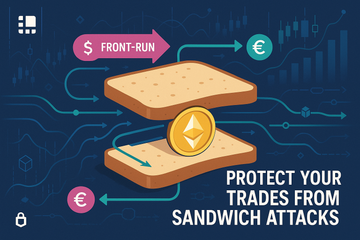If you've spent any time with decentralized exchanges or poked around the crypto space, chances are you've stumbled across the term sandwich trading. But if you haven't, don't worry—it's a subject that sounds a bit lighthearted, like something you might find on a quirky lunch menu, yet it's got teeth. Let me guide you through the world of sandwich trading, from how it works, to why it matters, and even how it intertwines with tools like Ledger or Trezor wallets.
Wait, What's With the Name?
First thing's first. Why call it 'sandwich' trading? Picture this: You're sandwiched between two slices of bread. In crypto terms, the 'bread' represents two trades—one before, one after—and the juicy filling is an unsuspecting trader's transaction right in the middle. This isn't a new restaurant opening, but rather a strategic move to manipulate prices, especially on decentralized exchanges.
How Does a Sandwich Attack Actually Work?
Here's the thing—when you submit a trade on a DEX (let’s use Uniswap as an example), it isn't executed instantly. There's a window of time when your intent is visible in the public memory pool, or mempool. That’s where the tricksters, often running clever bots, come sniffing for opportunities.
Here's a step-by-step breakdown:
- Spotting the Target: An attacker scans the mempool for pending transactions—often big trades with low slippage tolerance.
- Front-run: The attacker quickly places their own trade just before yours, typically buying the very asset you’re about to push up in price.
- Your Transaction: Your order goes through, moving the price—now not-so-much in your favor.
- Back-run: The attacker instantly sells the asset they just bought, benefiting from the price hike your trade caused. And just like that, you got sandwiched.
Annoying, right? That tiny slippage you get on your trade isn’t always an accident; sometimes, it’s the result of someone poking your wallet for pennies (or more).
Let Me Tell You Who's at Risk
So, who ends up as the filling? While everyone is technically exposed, it's usually folks making large swaps or those setting low slippage thresholds—think busy DeFi farmers or traders moving serious sums through protocols. If you’re swapping $10 worth of tokens, you might fly under the radar, but throw in thousands and well, you’re basically wearing a target sign.
Does It All Sound a Bit Unfair?
Absolutely. Sandwich trading, in the exploit sense, isn’t exactly greeted with applause by the community. It’s considered a kind of MEV (Maximal Extractable Value) strategy, meaning folks are squeezing out as much profit as possible from ordering transactions. And while decentralized setups bring transparency, they also offer visibility to everyone—including attackers.
Some might see it as clever. Most see it as a drain on trust and ecosystems. DeFi is supposed to be an even playing field, right? But shady tactics like this can scare off new users, especially when folks start realizing their trades are getting picked apart by invisible hands.
Remember When?
It’s far from ancient history. In 2023, several high-profile sandwich attacks on Ethereum-based DEXs made headlines, costing regular users thousands. That’s not something you want immortalized on-chain. (If you want to relive some of the mayhem, check out resources from Binance Academy or the Coinbase glossary for real-world case studies.)
So, What Can You Actually Do?
You know what? You might feel like DeFi is just a jungle of bots hunting for an easy snack, but there are ways to defend yourself:
- Increase Your Slippage Tolerance Cautiously: Lower isn’t always safer. If your slippage setting is too tight, your transaction might just get stuck. Too high, and you’re open season for sandwich bots.
- Time Your Trades: Bots are most active during high-volume periods. If you can, trade when things are quiet.
- Use Private Transaction Tools: Some platforms let you send orders directly to miners or through privacy relayers, skipping the mempool entirely. It's kind of like sending a secret note, instead of shouting your plans across the playground.
- Stay Updated: Follow trusted wallets, like Trezor or Ledger. Not only do they offer hardware-level security, but their educational resources often flag emerging trends and threats. Honestly, those folks do more than keep your coins safe from hackers. They help you steer clear of sketchy trading tactics too.
Let's Get a Bit Technical
For the nerds (and proud of it), sandwich attacks thrive because of how AMMs (Automated Market Makers) work. Protocols like Uniswap use formulas that instantly reprice tokens based on trades. When you shove a big trade into that formula, it’s predictable how the price will shift. That’s the loophole. Bots calculate exactly how to exploit it, often using the highest gas fees to jump the line. It’s a race, and—spoiler alert—the fastest bots usually win.
Is There Any Upside to This?
Arguably, sandwich trading shines a harsh light on DeFi's rough edges, forcing developers to get creative. It inspires new protective tech—like MEV blockers or specialized relayers—to keep attackers guessing. Think of it as an arms race, but with code instead of armor plates.
It’s Not Just About Attacks—There’s a Legit Side, Too
Almost feels strange, but here's an unexpected twist: a group called Sandwich Trading has popped up, offering a direct-to-exchange platform for serious traders. These folks focus more on transparent and secure access to big exchanges, local API key control, you name it. Not every sandwich is rotten, it seems.
The Takeaway
Sandwich trading isn’t going anywhere. Techniques evolve, bots get faster, but so do the defenses. Decentralized finance offers freedom, but that freedom comes with a side of vigilance. Keep your slippage settings in check, timing smart, and consider using hardware wallets and privacy tools. Next time you swap tokens, just remember—it pays to know who’s eyeing the bread and butter of your trade.
Want to dig deeper? You’ll find plenty more at the Ledger Academy and educational blogs from Trezor. Stay sharp, and your wallets—and your trades—will thank you for it.











